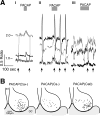Neuropeptide-mediated calcium signaling in the suprachiasmatic nucleus network
- PMID: 21039959
- PMCID: PMC3059748
- DOI: 10.1111/j.1460-9568.2010.07411.x
Neuropeptide-mediated calcium signaling in the suprachiasmatic nucleus network
Abstract
Neuroactive peptides and the intracellular calcium concentration ([Ca(2+) ](i) ) play important roles in light-induced modulation of gene expression in the suprachiasmatic nucleus (SCN) neurons that ultimately control behavioral rhythms. Vasoactive intestinal peptide (VIP) and arginine vasopressin (AVP) are expressed rhythmically within populations of SCN neurons. Pituitary adenylate cyclase-activating peptide (PACAP) is released from retinohypothalamic tract (RHT) terminals synapsing on SCN neurons. Nociceptin/orphanin FQ (OFQ) receptors are functionally expressed in the SCN. We examined the role of several neuropeptides on Ca(2+) signaling, simultaneously imaging multiple neurons within the SCN neural network. VIP reduced the [Ca(2+) ](i) in populations of SCN neurons during the day, but had little effect at night. Stimulation of the RHT at frequencies that simulate light input signaling evoked transient [Ca(2+) ](i) elevations that were not altered by VIP. AVP elevated the [Ca(2+) ](i) during both the day and night, PACAP produced variable responses, and OFQ induced a reduction in the [Ca(2+) ](i) similar to VIP. During the day, VIP lowered the [Ca(2+) ](i) to near nighttime levels, while AVP elevated [Ca(2+) ](i) during both the day and night, suggesting that the VIP effects on [Ca(2+) ](i) were dependent, and the AVP effects independent of the action potential firing activity state of the neuron. We hypothesize that VIP and AVP regulate, at least in part, Ca(2+) homeostasis in SCN neurons and may be a major point of regulation for SCN neuronal synchronization.
© 2010 The Authors. European Journal of Neuroscience © 2010 Federation of European Neuroscience Societies and Blackwell Publishing Ltd.
Figures







Similar articles
-
An essential role for peptidergic signalling in the control of circadian rhythms in the suprachiasmatic nuclei.J Neuroendocrinol. 2003 Apr;15(4):335-8. doi: 10.1046/j.1365-2826.2003.01005.x. J Neuroendocrinol. 2003. PMID: 12622830 Review.
-
Arginine-vasopressin and vasointestinal polypeptide rhythms in the suprachiasmatic nucleus of the mouse lemur reveal aging-related alterations of circadian pacemaker neurons in a non-human primate.Eur J Neurosci. 2005 Aug;22(4):902-10. doi: 10.1111/j.1460-9568.2005.04268.x. Eur J Neurosci. 2005. PMID: 16115213
-
Role of vasoactive intestinal peptide in the light input to the circadian system.Eur J Neurosci. 2015 Jul;42(2):1839-48. doi: 10.1111/ejn.12919. Epub 2015 May 25. Eur J Neurosci. 2015. PMID: 25885685 Free PMC article.
-
Nociceptin/orphanin FQ (N/OFQ) inhibits excitatory and inhibitory synaptic signaling in the suprachiasmatic nucleus (SCN).Neuroscience. 2005;132(4):955-65. doi: 10.1016/j.neuroscience.2004.11.057. Neuroscience. 2005. PMID: 15857701
-
Neuroglial and synaptic rearrangements associated with photic entrainment of the circadian clock in the suprachiasmatic nucleus.Eur J Neurosci. 2010 Dec;32(12):2133-42. doi: 10.1111/j.1460-9568.2010.07520.x. Eur J Neurosci. 2010. PMID: 21143667 Review.
Cited by
-
A Symphony of Signals: Intercellular and Intracellular Signaling Mechanisms Underlying Circadian Timekeeping in Mice and Flies.Int J Mol Sci. 2019 May 13;20(9):2363. doi: 10.3390/ijms20092363. Int J Mol Sci. 2019. PMID: 31086044 Free PMC article. Review.
-
Circuit development in the master clock network of mammals.Eur J Neurosci. 2020 Jan;51(1):82-108. doi: 10.1111/ejn.14259. Epub 2018 Dec 5. Eur J Neurosci. 2020. PMID: 30402923 Free PMC article. Review.
-
Inhibitory responses to retinohypothalamic tract stimulation in the circadian clock of the diurnal rodent Rhabdomys pumilio.FASEB J. 2022 Aug;36(8):e22415. doi: 10.1096/fj.202200477R. FASEB J. 2022. PMID: 35867045 Free PMC article.
-
Increased glutamic acid decarboxylase expression in the hypothalamic suprachiasmatic nucleus in depression.Brain Struct Funct. 2017 Dec;222(9):4079-4088. doi: 10.1007/s00429-017-1442-y. Epub 2017 Jun 12. Brain Struct Funct. 2017. PMID: 28608287 Free PMC article.
-
Peptide neuromodulation in invertebrate model systems.Neuron. 2012 Oct 4;76(1):82-97. doi: 10.1016/j.neuron.2012.08.035. Neuron. 2012. PMID: 23040808 Free PMC article. Review.
References
-
- Ajpru S, McArthur AJ, Piggins HD, Sugden D. Identification of PAC1 receptor isoform mRNAs by real-time PCR in rat suprachiasmatic nucleus. Brain Res Mol Brain Res. 2002;105:29–37. - PubMed
-
- Albers HE, Stopa EG, Zoeller RT, Kauer JS, King JC, Fink JS, Mobtaker H, Wolfe H. Day-night variation in prepro vasoactive intestinal peptide/peptide histidine isoleucine mRNA within the rat suprachiasmatic nucleus. Brain Res Mol Brain Res. 1990;7:85–89. - PubMed
-
- Albrecht U, Sun ZS, Eichele G, Lee CC. A differential response of two putative mammalian circadian regulators, mper1 and mper2, to light. Cell. 1997;91:1055–1064. - PubMed
-
- Anton B, Fein J, To T, Li X, Silberstein L, Evans CJ. Immunohistochemical localization of ORL-1 in the central nervous system of the rat. The Journal of comparative neurology. 1996;368:229–251. - PubMed
Publication types
MeSH terms
Substances
Grants and funding
LinkOut - more resources
Full Text Sources
Miscellaneous

